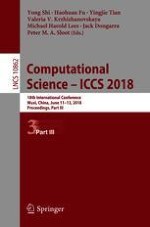The three-volume set LNCS 10860, 10861 and 10862 constitutes the proceedings of the 18th International Conference on Computational Science, ICCS 2018, held in Wuxi, China, in June 2018.
The total of 155 full and 66 short papers presented in this book set was carefully reviewed and selected from 404 submissions. The papers were organized in topical sections named:
Part I: ICCS Main Track
Part II: Track of Advances in High-Performance Computational Earth Sciences: Applications and Frameworks; Track of Agent-Based Simulations, Adaptive Algorithms and Solvers; Track of Applications of Matrix Methods in Artificial Intelligence and Machine Learning; Track of Architecture, Languages, Compilation and Hardware Support for Emerging ManYcore Systems; Track of Biomedical and Bioinformatics Challenges for Computer Science; Track of Computational Finance and Business Intelligence; Track of Computational Optimization, Modelling and Simulation; Track of Data, Modeling, and Computation in IoT and Smart Systems; Track of Data-Driven Computational Sciences; Track of Mathematical-Methods-and-Algorithms for Extreme Scale; Track of Multiscale Modelling and Simulation
Part III: Track of Simulations of Flow and Transport: Modeling, Algorithms and Computation; Track of Solving Problems with Uncertainties; Track of Teaching Computational Science; Poster Papers
